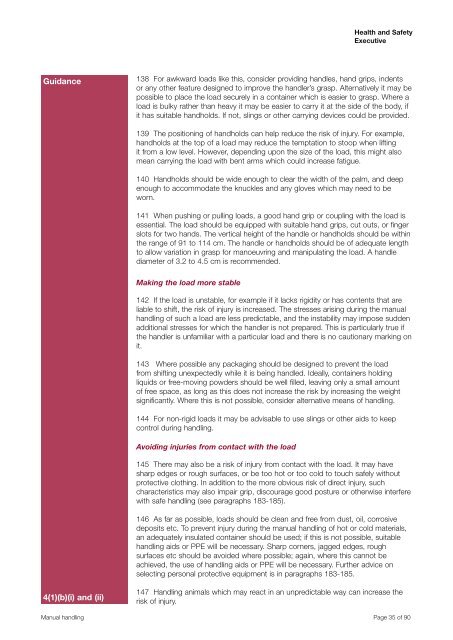Manual Handling Manual Handling Operations Regulations 1992 ...
Manual Handling Manual Handling Operations Regulations 1992 ...
Manual Handling Manual Handling Operations Regulations 1992 ...
You also want an ePaper? Increase the reach of your titles
YUMPU automatically turns print PDFs into web optimized ePapers that Google loves.
Health and Safety<br />
Executive<br />
Guidance<br />
138 For awkward loads like this, consider providing handles, hand grips, indents<br />
or any other feature designed to improve the handler’s grasp. Alternatively it may be<br />
possible to place the load securely in a container which is easier to grasp. Where a<br />
load is bulky rather than heavy it may be easier to carry it at the side of the body, if<br />
it has suitable handholds. If not, slings or other carrying devices could be provided.<br />
139 The positioning of handholds can help reduce the risk of injury. For example,<br />
handholds at the top of a load may reduce the temptation to stoop when lifting<br />
it from a low level. However, depending upon the size of the load, this might also<br />
mean carrying the load with bent arms which could increase fatigue.<br />
140 Handholds should be wide enough to clear the width of the palm, and deep<br />
enough to accommodate the knuckles and any gloves which may need to be<br />
worn.<br />
141 When pushing or pulling loads, a good hand grip or coupling with the load is<br />
essential. The load should be equipped with suitable hand grips, cut outs, or finger<br />
slots for two hands. The vertical height of the handle or handholds should be within<br />
the range of 91 to 114 cm. The handle or handholds should be of adequate length<br />
to allow variation in grasp for manoeuvring and manipulating the load. A handle<br />
diameter of 3.2 to 4.5 cm is recommended.<br />
Making the load more stable<br />
142 If the load is unstable, for example if it lacks rigidity or has contents that are<br />
liable to shift, the risk of injury is increased. The stresses arising during the manual<br />
handling of such a load are less predictable, and the instability may impose sudden<br />
additional stresses for which the handler is not prepared. This is particularly true if<br />
the handler is unfamiliar with a particular load and there is no cautionary marking on<br />
it.<br />
143 Where possible any packaging should be designed to prevent the load<br />
from shifting unexpectedly while it is being handled. Ideally, containers holding<br />
liquids or free-moving powders should be well filled, leaving only a small amount<br />
of free space, as long as this does not increase the risk by increasing the weight<br />
significantly. Where this is not possible, consider alternative means of handling.<br />
144 For non-rigid loads it may be advisable to use slings or other aids to keep<br />
control during handling.<br />
Avoiding injuries from contact with the load<br />
145 There may also be a risk of injury from contact with the load. It may have<br />
sharp edges or rough surfaces, or be too hot or too cold to touch safely without<br />
protective clothing. In addition to the more obvious risk of direct injury, such<br />
characteristics may also impair grip, discourage good posture or otherwise interfere<br />
with safe handling (see paragraphs 183-185).<br />
146 As far as possible, loads should be clean and free from dust, oil, corrosive<br />
deposits etc. To prevent injury during the manual handling of hot or cold materials,<br />
an adequately insulated container should be used; if this is not possible, suitable<br />
handling aids or PPE will be necessary. Sharp corners, jagged edges, rough<br />
surfaces etc should be avoided where possible; again, where this cannot be<br />
achieved, the use of handling aids or PPE will be necessary. Further advice on<br />
selecting personal protective equipment is in paragraphs 183-185.<br />
4(1)(b)(i) and (ii)<br />
147 <strong>Handling</strong> animals which may react in an unpredictable way can increase the<br />
risk of injury.<br />
<strong>Manual</strong> handling Page 35 of 90
















